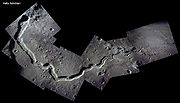
Vallis Schröteri
Encyclopedia

Rille
Rille is typically used to describe any of the long, narrow depressions in the lunar surface that resemble channels. Typically a rille can be up to several kilometers wide and hundreds of kilometers in length...
on the surface of the near side of the Moon
Moon
The Moon is Earth's only known natural satellite,There are a number of near-Earth asteroids including 3753 Cruithne that are co-orbital with Earth: their orbits bring them close to Earth for periods of time but then alter in the long term . These are quasi-satellites and not true moons. For more...
. It is located on a rise of continental ground, sometimes called the Aristarchus plateau, that is surrounded by the Oceanus Procellarum
Oceanus Procellarum
Oceanus Procellarum is a vast lunar mare on the western edge of the near side of the Earth's Moon. Its name derives from the old superstition that its appearance during the second quarter heralded bad weather...
to the south and west and the Mare Imbrium
Mare Imbrium
Mare Imbrium, Latin for "Sea of Showers" or "Sea of Rains", is a vast lunar mare filling a basin on Earth's Moon and one of the larger craters in the Solar System. Mare Imbrium was created when lava flooded the giant crater formed when a very large object hit the Moon long ago...
to the northwest. At the southern edge of this rise are the craters Aristarchus
Aristarchus (crater)
Aristarchus is a prominent lunar impact crater that lies in the northwest part of the Moon's near side. It is considered the brightest of the large formations on the lunar surface, with an albedo nearly double that of most lunar features. The feature is bright enough to be visible to the naked eye,...
and Herodotus
Herodotus (crater)
Herodotus is a lunar crater located on a low shelf in the midst of the Oceanus Procellarum. To the east is the slightly larger crater Aristarchus. West across the mare is Schiaparelli. Almost due south on the mare surface is a solitary lunar dome designated Herodotus Omega .The crater Herodotus has...
.
This is the largest sinuous rille on the Moon. It begins at a 6 km diameter crater located 25 km to the north of Herodotus. (The start of the rille has been termed the "Cobra's Head" by some observers, due to its resemblance to a snake.) From the crater it follows a meandering path, first to the north, then setting a course toward the northeast, before finally bending back to the south until it reaches a 1 km high precipice at the edge of the Oceanus Procellarum. The rille has a maximum width of about 10 km, then gradually narrows to less than a kilometer near its terminus.
The origins of this rile are believed to be volcanic. The interior floor has been resurfaced and is very level. However there is a slender rille located on the floor, not visible to observers on the Earth
Earth
Earth is the third planet from the Sun, and the densest and fifth-largest of the eight planets in the Solar System. It is also the largest of the Solar System's four terrestrial planets...
.
The rille has been the subject of numerous transient lunar phenomena observations.
The selenographic coordinates
Selenographic coordinates
Selenographic coordinates are used to refer to locations on the surface of Earth's moon. Any position on the lunar surface can be referenced by specifying two numerical values, which are comparable to the latitude and longitude of Earth...
of this valley are , and it has a maximum diameter of 168 km. It is named for Johannes H. Schröter.
It was also the planned site for the canceled Apollo 18
Apollo 18
Apollo 18 may refer to:* One of the canceled Apollo missions of the American Apollo lunar program* The officially unnumbered Apollo spacecraft used in the Apollo–Soyuz Test Project* Apollo 18 , a 1992 album by They Might Be Giants...
mission.

